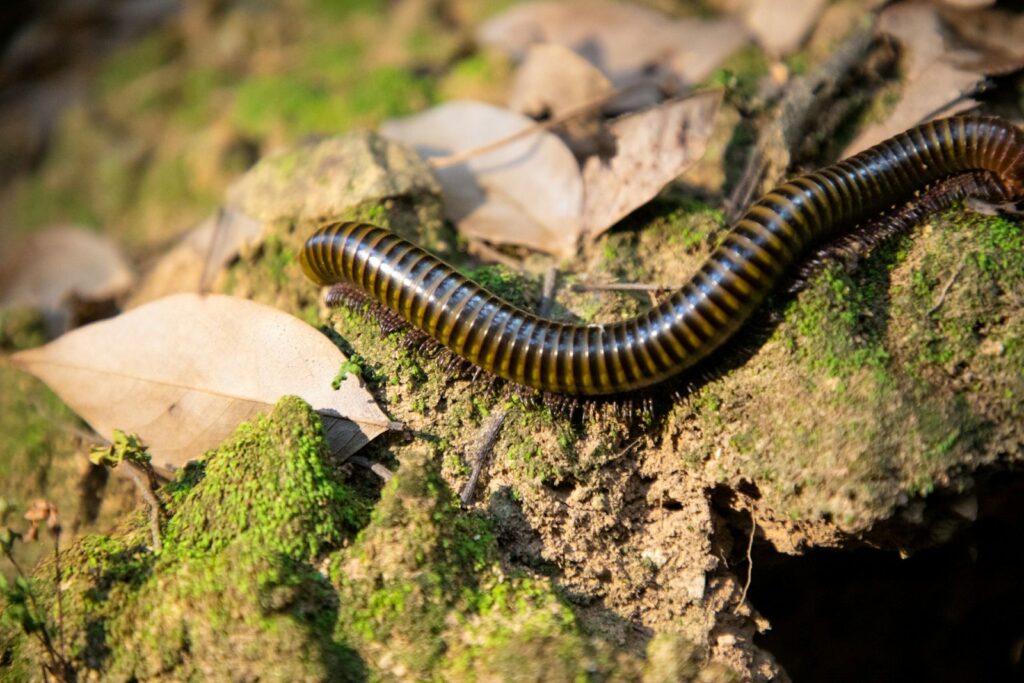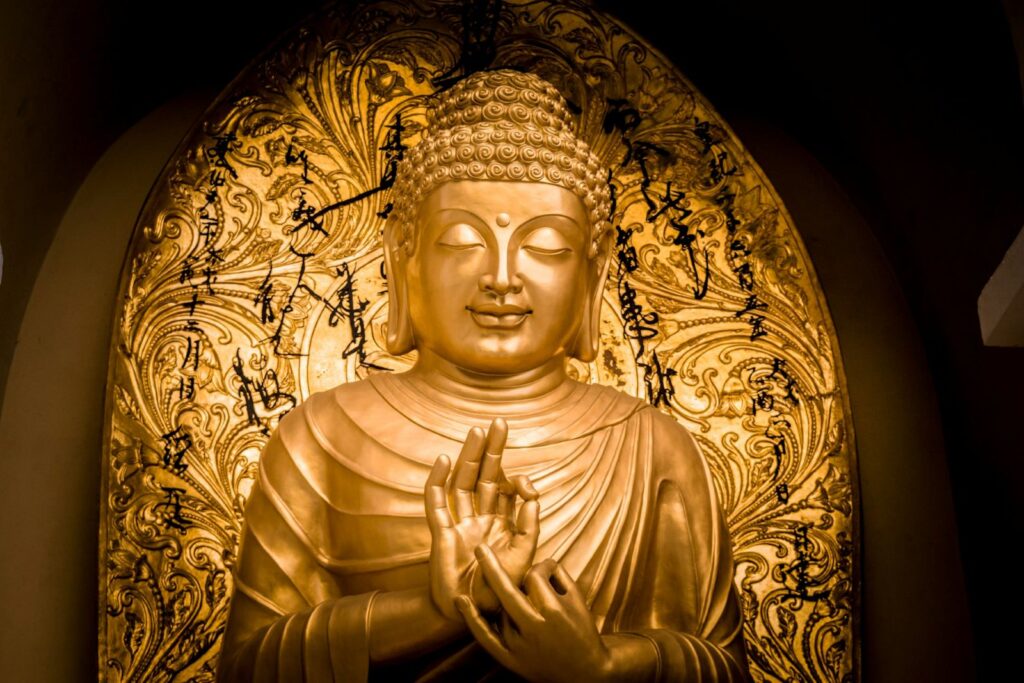One of my guiding principles is that the universe is always communicating with us, so when something unusual happens – like this week – I pay attention. The other day, something small and slender drooped from the top bar of my shower stall. Was it caulk? The glue unfurling? No. It was a millipede.
For context, I live on the second floor, and my bathroom is nowhere near anything natural like a tree. Also, I’ve lived here for nearly 11 years, and I’ve never seen a millipede in my home before. In other words, this isn’t a common occurrence. This millipede essentially appeared out of thin air, and I’m choosing to believe it was to tell me something.
I googled the shamanic meaning of millipede and nothing resonated until I read a post from the website Symbols and Synchronicity, where the author wrote that millipedes are messengers. “Not messengers in the way of grand declarations, but gentle ones—quiet teachers reminding us that transformation is not always loud,” she said. “Many traditions hold them close, seeing in their patient crawl the essence of protection, endurance, and hidden strength. . .The millipede, coiling slow and sure, brings lessons in groundedness and trust in the path beneath our feet.”
I won’t quote the entire piece – even though it’s gorgeous and I recommend reading it – but here are a few more parts that jumped out at me: “[The millipede] teaches in silence. No bark, no roar, no teeth. But you follow her for a while and she’ll show you how to go on when everything says stop. She’ll teach you to live like the forest floor lives: slow, patient, making something rich out of all that has fallen apart.”
And one more quote: “So if she comes, stop. Get low. Lay your palm to the ground and say thank you. For the lesson. For the witness. For the reminder that the slow way is not the wrong way. That you can lose things, many things, and still go on. That your healing, like hers, may come not in leaps—but in inches. And that is holy, too.”
When I read the piece from Symbols and Synchronicity, tears started streaming down my cheeks, and even now I’m getting choked up, because this year has been like that. Losing things, grieving dreams, releasing old ways of being. It’s been a deep and slow healing process. And oftentimes I feel like I’m backsliding, that I’m not making any progress at all. But then I get a message from the millipede, who says, “You’re healing in inches.”
No one else may notice the healing; I might not be able to broadcast it like a story on the 6 o’clock news, but it’s happening. This subtle growth is fitting for the season we’re in, too, in the Northern hemisphere. Winter is about hibernation, taking things slow. I know that’s counter to the messaging we get around the holidays but that doesn’t make it any less true.
The millipede reminds us to go slow, to remember slow is not bad or wrong. Sometimes it’s the only way and it’s still beautiful and worthwhile. Sometimes healing happens in inches, not leaps, and it’s still worth celebrating.
I dream of a world where we understand healing doesn’t always look the way we expect it to look. A world where we recognize it’s often slow and deep. A world where we celebrate the progress we’ve made, even if no one else can see it. A world where we remember that sometimes healing happens in inches, not leaps.
Another world is not only possible, it’s probable.
It’s funny, or perhaps timely, that as we approach the longest night of the year in the Northern hemisphere that I’m thinking of light, both literal and metaphorical. On the metaphorical level, I very much relate to the story of the Golden Buddha.
Several hundred years ago in Thailand, monks covered a giant golden Buddha statue with clay to protect it from an attack by the Burmese army. During the attack, the monks were killed, so no one knew that beneath the clay was actually a golden Buddha. It wasn’t until 1957 when some monks attempted to relocate the Buddha that this discovery was made. They noticed a large crack in the clay, through which streamed something gold. The monks used a hammer and chisel to chip away at the clay exterior until it was revealed that the entire statue was made of solid gold.
I feel like that clay Buddha. The past several months have been a process of chipping away at my exterior – all the limiting beliefs, all the maladaptive coping strategies, all the everything that’s kept me from being my true self. The whole thing has been deeply painful. As if to encourage me during this process, I pulled an oracle card the other day. Here’s an excerpt of what it said:
“Through the natural process of transformation, great leaps are indeed possible. The situations in your current life are particularly geared toward a more significant manifestation that is coming to you according to your life path and purpose. This is a stage of preparation and building a foundation that will hold you strong and centered as your creative journey unfolds and your life path becomes ever more brilliant and luminous. Be hopeful and trust in the light you sense within you, for this light that is within you is simply revealed more fully. An affirmation for you: ‘I surrender what is into the loving fire of transformation. The light within me illuminates the present and manifests the future in the highest creative expression of unconditional love.’”
When I pulled that oracle card, I cried because it struck me that everything I’m going through isn’t just a growth opportunity – it’s all setting me up for a stronger, more centered self. It’s setting me up to be happier. And it’s forcing the real me to shine through. Because of the way I’m oriented, I also think about how becoming ever more luminous helps other people.
It’s currently Hanukkah, which, yes, celebrates a war battle, but it’s also a symbolic battle where we remember the flame of one lamp lights up countless others, both literally and metaphorically. When we spread our light, our goodness, we light up other people. And together, we create a row of lights such that darkness retreats.
There’s a lot of darkness in the world, but there’s also a lot of light, both literally and metaphorically. People are hanging lights in their homes to bring in more literal light, but they’re also doing kind things for one another to bring in more metaphorical light. They watch their friend’s kid, they volunteer, they show up to protect immigrants. People all over the world are letting their goodness shine through and becoming ever more luminous. In this holiday season, that’s my wish for you, too.
I dream of a world where we recognize sometimes we go through hard things because ultimately it will take us somewhere happier and healthier. A world where we understand beneath a clay exterior, there lives a golden Buddha within each of us. A world where we let our light shine and become ever more luminous.
Another world is not only possible, it’s probable.
I keep thinking about the movie Under the Tuscan Sun so I decided to recycle one of my posts about it. This one is from January 2012. Enjoy.
I have preconceived notions of what my life will look like and how I will get my needs met. What I’m finding out, though, is the universe takes care of me in ways I didn’t think it would. For instance, this week I’ve been sick. So sick I didn’t leave the house for three days and mainlined tea like it was my job. I had this idea that the only people who would take care of me when I’m sick are my mom and my boyfriend. Well, my mom lives in Seattle, and my boyfriend is nonexistent, so I resigned myself to being really pathetic on the couch. You know what happened, though? My good friend came over and made me dinner and tea.
My needs are getting met, just not how I thought they would. It reminds me of one of my favorite movies, Under the Tuscan Sun. At the beginning of the movie, Diane Lane’s character says she wants a family in her house, a wedding, and someone to cook for. At the end of the movie, she has all those things. Her best friend and her best friend’s baby moved in, she held a wedding for a neighbor, and the people to cook for were the contractors on her house. Her wishes came true, but in a different form than she anticipated.
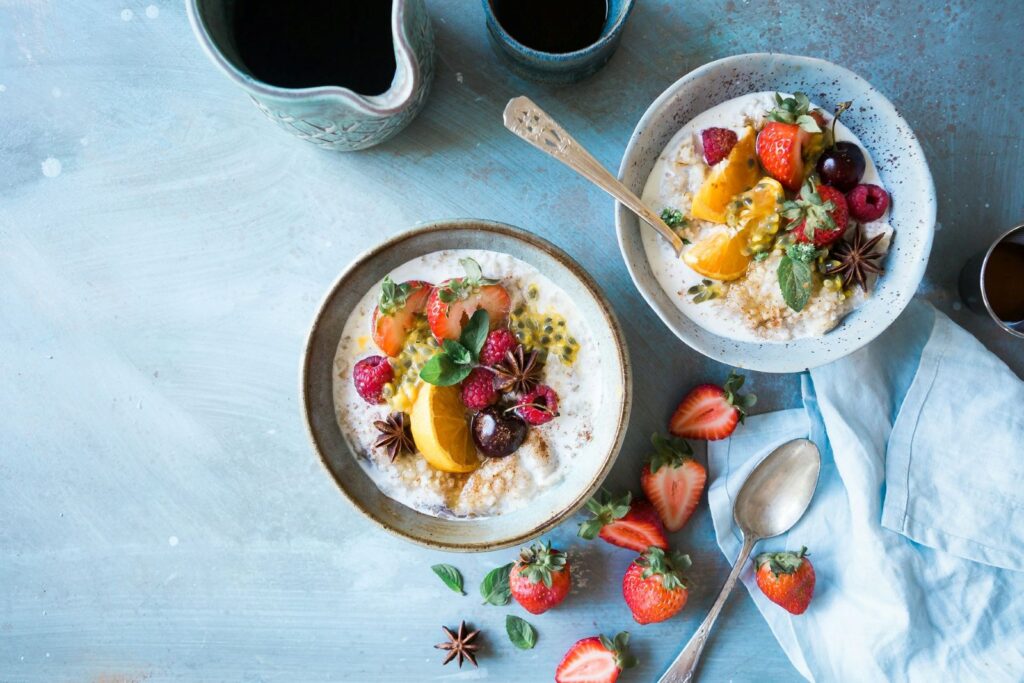
I’m going to pretend this is all vegan! Photo by Brooke Lark on Unsplash
My view is limited. I can get tunnel vision with how I think things should go but my higher power sees everything. My higher power says, “I will give you everything you want and more, but it’s going to come out of left field.” I didn’t expect anyone I’m not dating would voluntarily make me dinner while being sick. But here was this friend doing exactly that.
I don’t need to get caught up in the “how” of things – I can instead let the universe work its magic. Doreen Virtue has a great quote where she said we want to hand life a script and quibble about what’s on page 42. I don’t want to quibble about page 42 anymore. I would rather say, “Hey God, here’s what I want, here are my needs and desires, I know they’ll be fulfilled, and I look forward to seeing how you make it happen.” Because in the end, it most likely will look different than I think it will.
I dream of a world where we’re open to all possibilities. A world where we understand our needs and desires get met in interesting and unique ways. A world where we don’t hand the universe a script because we realize it’s more like improv – there are certain parameters, but for the most part, stuff gets made up on the fly. I dream of a world where we rest easy knowing we’ll get exactly what we need as long as we’re open to whatever form that will take.
Another world is not only possible, it’s probable.
You may be tired of hearing about gratitude, but at the risk of overloading you, I want to talk about gratitude. Author and speaker Case Kenny reminded me recently of a powerful way to feel grateful. I don’t know about you, but gratitude can start to feel rote. Like, of course, I’m grateful for clean drinking water and a safe place to live. But do I always feel that in my body? I wish I did, but I do not.
Case said to up the ante on gratitude, think back to when things were challenging and compare that to how things are now. So, remember the time you broke your leg, and you’ll feel grateful you can walk unencumbered. Or reflect on that camping trip where all your belongings got soaked, and you’ll feel grateful you’re not sleeping in a tent.
As for me, I’m feeling grateful for something as simple as being able to sit upright. Last Monday, I was hit with the worst case of vertigo of my life. If you’re unfamiliar, vertigo means you’re dizzy and the entire room is spinning even though you’re not moving. For some people, like me, their eyes dart back and forth uncontrollably when they sit or stand. There’s no medication for vertigo because the issue is with the inner ear. When an ear crystal, which controls balance and orientation, gets dislodged, you experience vertigo.
The solution is to reset the inner ear with various maneuvers. Well, I tried all those maneuvers and they didn’t work. So I spent 16 hours lying in bed because I couldn’t move without the world spinning. It was so bad that I couldn’t refill my water glass or get anything to eat. It was so bad that even though a few people offered to come over to support me, I couldn’t leave the bed to unlock the door.
After tossing and turning the entire night, the ear crystals reset. I’m still recovering – my head and neck tried really hard to stabilize so they’re stiff and sore – but thankfully, the vertigo is gone. I didn’t think I’d be grateful for something I take for granted literally every day, but I am. I’m reminded of how easily I could be incapacitated, of how fragile the human body is, and so today, I’m grateful.
Gratitude is also on my mind not because we recently celebrated Thanksgiving here in the U.S., but because it’s my birthday on December 1. As I get older, I’m constantly reminded that nothing is promised. There’s no guarantee that any of us will reach a certain age, and so every year truly feels like a celebration.
What’s interesting is that my last birthday was emotionally fraught because I turned the big 4-0 and my life didn’t (and doesn’t) look how I thought it would. I had so many feelings about hitting that milestone, and this year, things feel simpler. This year, I’m just enjoying that I’m here, that I’m alive, and that I’m loved. Not only is that enough, it’s everything. So yeah, I’m grateful. And I hope you find something to be grateful for, too.
I dream of a world where we reflect on when things went wrong so that we’re grateful when things go right. A world where we feel grateful for the smallest things because we recognize there are no guarantees in this life. A world where we practice a new way to give thanks.
Another world is not only possible, it’s probable.
I do plan to write original content again but today is not that day. This post is from August 2024. Normally, I don’t like to recycle content written in the past year, but what’s most true for me right now is the need to be where I am, and the need to go slow. Enjoy.
An emotion I feel frequently is frustration, and it’s usually because people and situations aren’t moving as fast as I’d like. I don’t mean literally – I’m not a speed demon – I mean in terms of actions. A frequent complaint I have is, “Why is this taking so long?” That’s everything from a person returning my telephone call to becoming a bestselling author. I want everything yesterday. The whole “waiting” thing is a ripoff, if you ask me.
Given my penchant for moving quickly, it should be no surprise that the universe gives me plenty of opportunities to practice patience. I’ve written dozens of posts about patience over the years, including earlier in the year when I wrote about the future unfolding. I know that things bloom when they’re ready, and we’re looking at our watches while God is looking at the calendar. But even with all those posts, I still want things to move quickly! This might also be a good time to mention it’s taken me three times as long to write this post as my other ones, and that even writing a post about it being OK to go slow, I want to go fast. And not only do I want to go fast, I want to be somewhere I’m not.
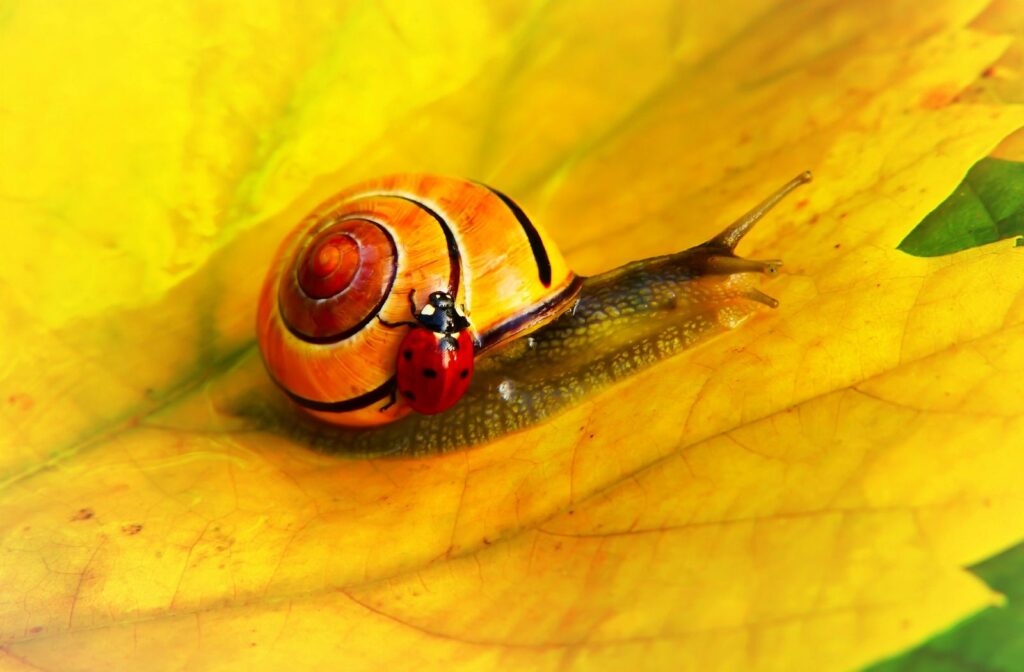
A snail AND a ladybug! It’s OK to go slow. Photo by Krzysztof Niewolny on Unsplash
I’m struggling with what to say, but when I let my writing flow in the form of a letter, the words poured out. Here’s a letter to me from my Great Self, but maybe your Great Self wants you to hear it too:
“I know you want everything yesterday. I know nothing moves as quickly as you’d like. You see the endgame, you know how things could be. It’s one of your gifts to dream, to imagine. It’s the creative spark that lives within you, seeking expression. You have an active mind and that’s one of the best things about you.
“It’s easy for you to make big jumps, to go from A to Z very quickly but not everyone else is like that. Other people need to take baby steps. They need to move more slowly. They need time for their brains and bodies to catch up. It’s OK for you to match their pace, it’s OK for you to go slow. It’s OK for you to rest and relax and know that everything is going exactly as it should at the pace it should. That includes your emotional states.
“What I really want you to know is you aren’t alone; you aren’t doing all this by yourself. It’s not your self-will that’s making things happen. It’s you matching the universal, Cosmic rhythm. It’s you syncing your desires with the Cosmic desires. It’s the outside world pouring into you, supporting you.
“When you want to rush, think about the natural world. You may want to harvest blueberries right now, but you have to wait for a bud, then a bloom, then a blueberry. The natural world knows how to move slowly. It’s the human world that does not. It’s people who say you should have this accomplished by this age, and if you don’t, you’re a failure. It’s the human world that touts overnight successes and doesn’t honor the people who write four books before they publish a bestseller. It’s the human world that tells you that you should be moving at a pace other than the one you’re moving at.
“All of nature is here telling you it’s OK to go slow, to be where you are, that you can take all the time you need. Rest, be gentle with yourself, and know there’s nothing shameful or wrong about incrementally working toward the things you want. That’s usually how it happens.
“Remember that your spiritual teacher says, ‘Suppose, immediately after planting some saplings and seeds, someone digs them up to find out if they have taken root or sprouted. That would not be considered wise.’
“Sometimes you have to wait for your desires to be expressed, but there’s nothing wrong with that. It’s natural and the way the world works. You’re doing great and even though you don’t believe it, all is well, my dear, all is well. Go as slow as you need to go. What is meant for you will not run past you. Trust that. And trust that you are exactly where you need to be.”
I dream of a world where we remember it’s humans who tell us to rush and go as fast as possible. A world where we understand nature models slow and steady progress. A world where we recognize it can take a while for our dreams and desires to sprout but that doesn’t mean they aren’t blossoming. A world where we remind ourselves it’s OK to go slow. A world where we let ourselves be where we are.
Another world is not only possible, it’s probable.
We’re still in a time machine this week. I’m noticing I’m slowly chipping away at the obstacles before me, and this post from December 2018 gives me hope. May it do the same for you.
When I thought about what to write this week, the image that kept coming to mind was a sea wall battered by waves. That’s a lot of what 2018 felt like to me – ceaselessly buffeting an immovable object until finally the object disintegrated. That’s what happens to sea walls – they must be replaced every 30 years or so, depending on how well they’re constructed.
I haven’t fully processed everything that happened to me this year. It still feels surreal that issues I battled for so long are suddenly gone. It’s strange to no longer feel the weight of them like an anchor around my neck. But obstacles are like that – if we keep battling them, eventually they evaporate. When people said that to me at the beginning of the year, I didn’t believe them. Instead, I rolled my eyes because it felt like my obstacles were insurmountable, that I’d be dealing with the same things for years to come.
And now here I am at the end of the year, and I no longer wake up feeling like a zombie. That probably doesn’t sound like a big obstacle, just go to sleep at a decent hour, right? Except as I wrote in “Minor Miracles,” sleep wasn’t so easy. I consulted Eastern and Western medicine seeking help for sleep, and it wasn’t until late August I found out I have upper airway resistance syndrome. I spent seven solid years with brain fog, low energy, and dread about going to bed. Now, the brain fog is gone, my energy levels are steadily increasing, and going to bed doesn’t fill me with as much trepidation. The obstacle I thought I’d be dealing with until I died is suddenly gone.
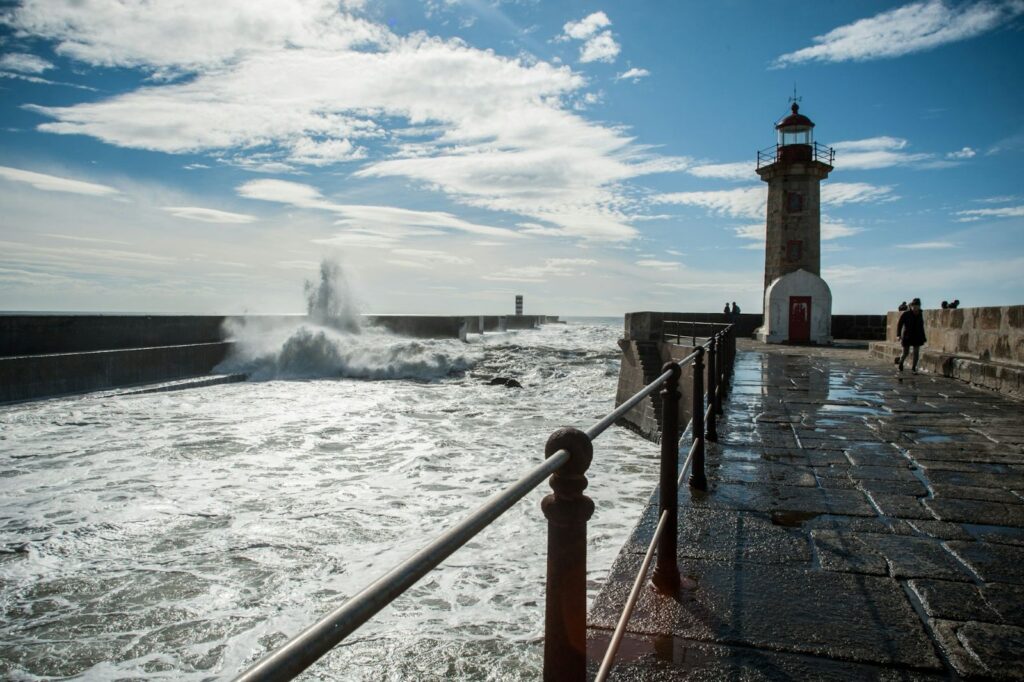
Continuous waves spell eventual collapse for this wall. Photo by Maksym Kaharlytskyi on Unsplash
I can imagine my spiritual teacher giving me a knowing smile. He is a Pollyanna type and says difficulties can never be greater than our capacity to overcome them, and that we’ll overcome all obstacles. He doesn’t allow for any possibility of defeat, even if it takes lifetimes. When I consider a sea wall, I wonder if perhaps his view is more realistic. There’s no way a sea wall can withstand the constant pressure from the sea, the wear and tear of salt, sand, and sun. There are too many elements at play.
Maybe we human beings are like that. Maybe there are multiple unseen forces at work in our lives, acting like the salt, sand, and sun that mean we, too, will be victorious. I don’t want to make it seem like overcoming obstacles is easy, because it’s not. But this year has given me a new appreciation and a new understanding for scaling them. When we do the slow and steady work, eventually the obstacle must collapse.
Sometimes we think things won’t change, or that impediments are too vast, but if we keep doing the work, if we keep putting one foot in front of the other, eventually the sea walls come down. May we all remember the power of persistence and carry it with us in the months and years to come.
I dream of a world where we recognize the power we all have. A world where we understand the truth about obstacles. A world where we remember if we keep chipping away at whatever is before us, eventually it will crumble. A world where we understand the power of persistence.
Another world is not only possible, it’s probable.
I don’t have a good reason as to why I’m resharing this post from September 2017 – I didn’t rewatch Hamlet, for instance – but it’s what we call in the journalism world “an evergreen,” meaning it’s relevant at any time. Enjoy.
This weekend, I watched Hamlet with a friend of mine and remarked how the play touched me in a way it didn’t when I was a teenager. I’ve seen Hamlet on numerous occasions, I’ve heard the famous soliloquy a million times, and even unknowingly quoted from the play in this blog.
Hamlet is a story I’m familiar with, but watching it this weekend, I could relate to him; I understood him in a way I hadn’t before. No, my uncle did not kill my father and marry my mother, but I, too, have experienced anger, grief, and despair. As I watched Hamlet this weekend, all I could think was, “Me too.” I wouldn’t have taken the actions he took, but I empathize with his feelings in a way I didn’t before.
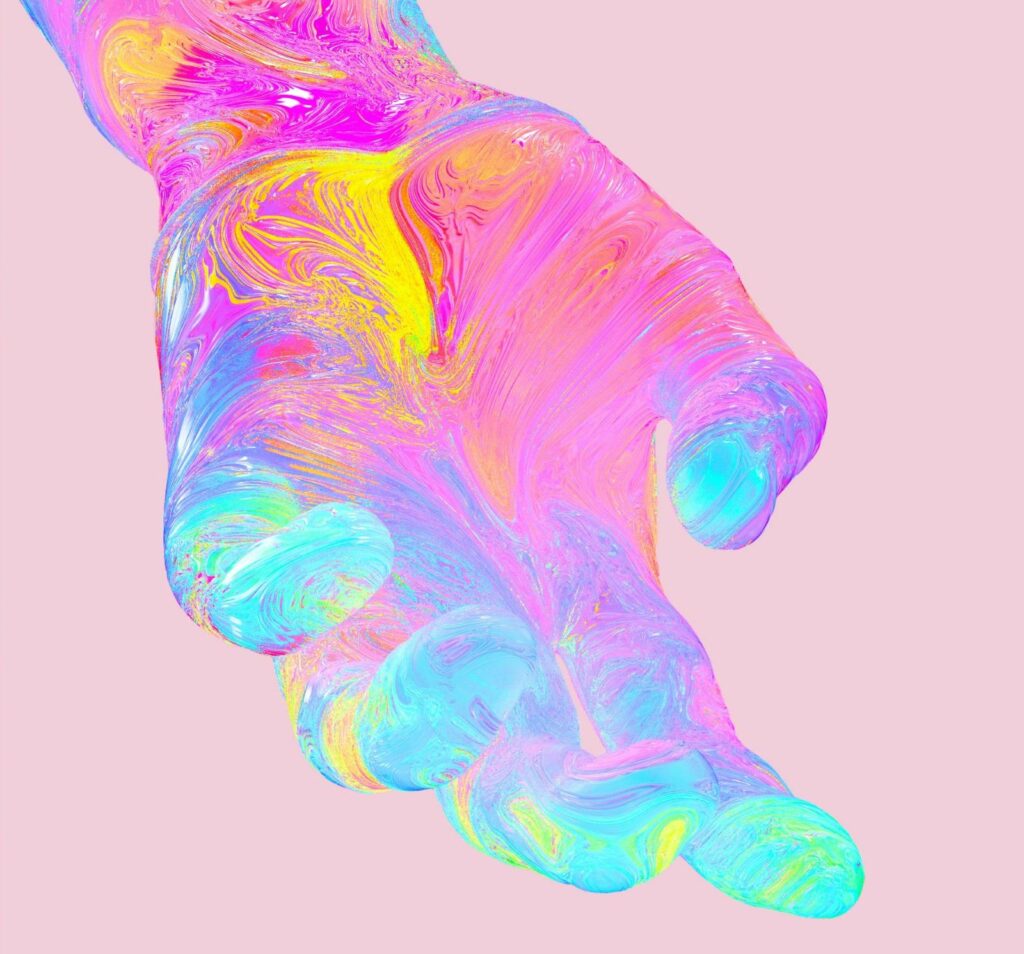
We all feel the same things. Photo by Maxim Berg on Unsplash
I’m reminded of that quote by Maya Angelou, who said, “We are all human; therefore, nothing human can be alien to us.” Yes! I’m not a scholar, but it seems to me Shakespeare’s work endures because he taps into the essence of what it means to be human, with all the pain, glory, comedy, and tragedy. One minute, Hamlet is contemplating suicide, and the next, his friends burst through the door, talking and laughing. That’s certainly how my life is. I think I mentioned it here, but literally the day after I found out my co-worker died, I unintentionally participated in a wedding held in my neighbor’s backyard. My windows were open, so the sounds of the ceremony wafted through the air. Life is tragic and comic, something Shakespeare understood and illustrated.
Even though he wrote his plays hundreds of years ago, they’re still relevant. There is no emotion anyone has ever felt that I haven’t felt too. Our experiences? Highly variable. Our emotions? The same. I bring this up because I wonder how things would be different if we all held this viewpoint. Instead of calling Mexicans rapists like a certain high-ranking official, instead of calling people aliens, what if we recognized that we are all human and thus nothing human can be alien to us?
My spiritual teacher said:
Human society comprises various races. There is no reason whatever to recognize one race as superior to another race. The external differences in constitutions among these human groups cannot alter their basic human traits – love and affection, pleasure and pain, hunger and thirst. These basic biological instincts and mental propensities equally predominate in human beings of all complexions in all countries and in all ages. A mere rustic, illiterate, half-naked tribal mother of an unknown hamlet … in India bears deep maternal affections for her young children; in the same way, a well-educated mother of a locality of New York pours out of her heart a great love for her own children.
The subterranean flow of love and affection exists in all hearts alike. Every person cries out in pain, everyone feels pleasure when there are occasions of joy and happiness. [F]undamentally, their mental existences flow along the same channels of ideas and consciousness. Containing the same cosmic momentum and under the same cosmic inspiration, they all have set out for a tryst with the same destiny.
That means we have more similarities than differences. We are all like one another. We are all human, and we’d do well to recognize that.
I dream of a world where we recognize we all have the same human emotions. A world where we remember there is nothing anyone can feel that we also haven’t felt, and vice versa. A world where we understand we aren’t so alien from each other, and in fact, humans aren’t aliens at all.
Another world is not only possible, it’s probable.
On Saturday, I visited my old San Francisco neighborhood for the first time in years. It was weird to compare what it used to look like to what it looks like now. It was also strange to be there and remember the person I used to be. My friends asked me if I missed living in the city, and the truthful answer is no.
It’s funny because in 2012, when I began my period of moving on average every three months for three years, I cried buckets over no longer being in SF. It was a heartbreak on par with a breakup. I’d spent ages longing to move to San Francisco, dreaming about it, imagining what my life would be like, and then when I arrived, it was the culmination of a dream. I loved being in the city. I loved the convenience, the ease, the energy. I woke up every day grateful I lived in San Francisco.
And then, the universe basically forcibly removed me. My dream became a nightmare. My building put up scaffolding to paint the exterior, and I kept telling management I was worried someone would break in. And guess what? They did! Not to my apartment, but still. And then, because of the paint job, my windows were covered so I couldn’t even see outside, and barely had any sunlight. Add in not sleeping through the night, and it was truly a waking nightmare.
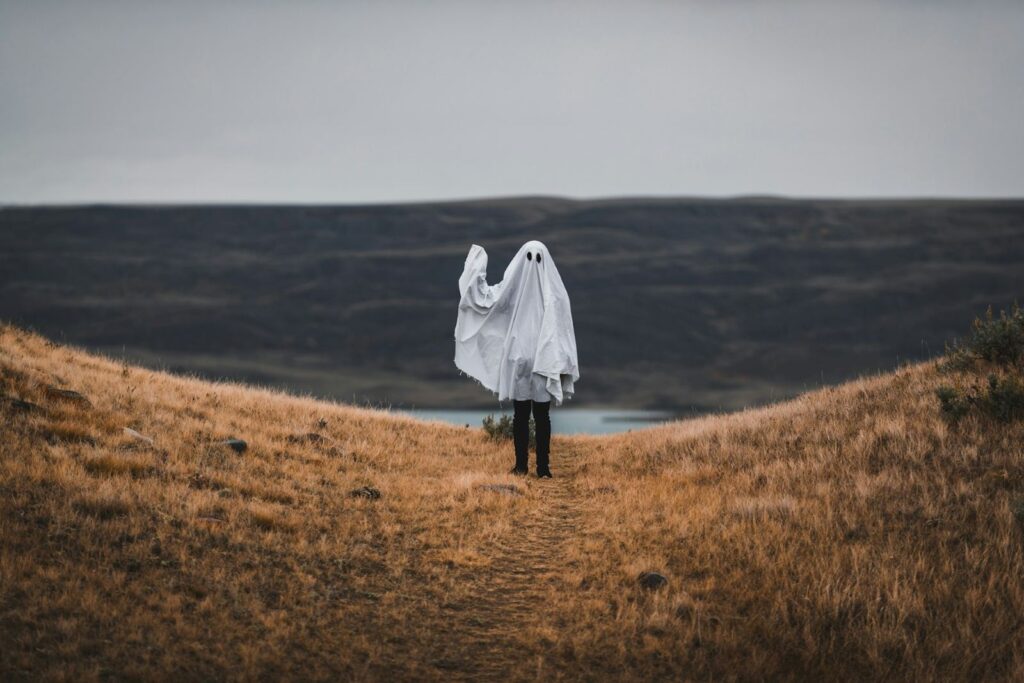
Hello past self. Photo by Tandem X Visuals on Unsplash
I left SF, but I wasn’t happy about it. I wrote poems about it, longed for the life I had, but kept moving forward. And now, I’m so changed that whenever I return to my old neighborhood, it’s like those feelings, that life, belonged to someone else. It’s like I’m confronting the ghost of my past self. That makes sense given what my spiritual teacher has to say about death and change.
He says, “A 5-year-old child is transformed in due course into a 15-year-old boy. In 10 years, the child becomes the boy. Thereafter, you will never be able to find the body of the 5-year-old child. So the child’s body has certainly died.” He then goes on to mention the boy growing into a man, and then hitting middle age, then old age, until he finally dies and says, “The rest of the changes we do not call death; but in fact, all the changes qualify as death.”
All the changes qualify as death because the person who used to exist cannot be found anymore. That’s me. I have died many times and will do so again. And it’s true for all of us. We’re constantly undergoing a metamorphosis. We’re constantly dying and being reborn. We all have many “ghosts” walking around. The people we used to be, and aren’t any longer.
Normally, I’d feel sad or tender about that, but it can also be something wistful or neutral. I have gratitude and appreciation for my past self, for the young woman who so desperately wanted to move to San Francisco and did. But I’m not that person anymore. These days, I have new dreams, new desires, and new selves to meet. And I’m sure that one day in the future, I’ll look back and think of this current self as a ghost, too.
I dream of a world where we recognize change is constant, not only in the world but in ourselves. A world where we understand that we will all die many times while we live. A world where we recognize there are many ghosts of our past selves walking around.
Another world is not only possible, it’s probable.
I, like many, have been amused and surprised by the Louvre heist. As a quick refresher, at 9:30 in the morning, thieves in yellow vests scaled a truck-mounted ladder to the second-floor balcony of the Apollo Gallery, home to the French crown jewels, among other treasures. Using an angle grinder to force open a window, they took just four minutes to enter the room, cut open two cases displaying Napoleonic jewels, grab nine pieces, and flee back down the ladder, according to CNN.
Instead of focusing on the heist itself or the ethics surrounding museum acquisition, theft, etc., I want to talk about why I think the story is so compelling. The museum heist is giving major trickster energy. The trickster is an archetype that crosses and often breaks both physical and societal rules. Tricksters “violate principles of social and natural order, playfully disrupting normal life and then re-establishing it on a new basis,” according to author Lewis Hyde.
There are many myths about the trickster from Indigenous tribes, often centering around coyote, spider, or raven. Here’s an abbreviated version of a story about Raven demonstrating how the trickster often makes things better for everyone:
Raven was told of a well with a never-ending supply of water. When Raven arrived, it learned the man who owned the well kept it covered and never left its side. He even built his house around the well and slept by it so that no one else could drink from it. But Raven began to scheme how to get this water.
Raven disguised itself as the man’s brother-in-law and went to the man, telling him he would stay the night with him. Both went to sleep, and in the early morning, Raven left and procured dog dung that he put on the sleeping man’s butt. Raven woke the man and showed him the “accident” he had in the night. The man, embarrassed, ran out of the house to clean up. While he was away, Raven drank nearly all the water, but he was caught when the man returned. Raven escaped and flew over the land, spitting water here and there, creating the great rivers of the world.
This is the myth certain Indigenous tribes use to explain the presence of great rivers, and while in this case the Raven did something good for all of humanity, I’m not sure that’s true for the museum heist. But what interests me about the trickster is many Indigenous communities think tricksters are essential, that they help us contact the sacred. Even in sacred ceremonies, tricksters are embedded in the ceremony and mock people, make crude jokes, and crawl down ladders headfirst. They do this because these communities say the sacred comes to us through upset, reversal, surprise.
Until I listened to the Emerald Podcast, I’d never heard of that concept, but it’s so true. Some of my biggest periods of transformation arrived on the heels of upset, reversal, and surprise. I want life to go according to my plans. I want things to be neat and orderly, but they never are. What if instead of fighting that, I accepted it? What if I made space for disruption because it’s going to happen anyway? We like to pretend it doesn’t or won’t but the museum heist, the political situation, heck, even the weather, demonstrate that disruption is not the exception, it’s the norm.
For me, welcoming the trickster means accepting upset, reversal, and surprise are a part of life. Just as life is a wheel, it’s also surprising. I don’t want to keep fighting that aspect or pretending I’m in charge or in control when I’m so clearly not. This is one of the biggest spiritual lessons I’ve had to learn over and over again: surrender. For today, surrender means not only accepting that the trickster is a part of life but actively welcoming it and saying, “I’m making space for you.”
I dream of a world where we understand things never go according to plan and they aren’t supposed to. A world where we recognize the trickster is an archetype for a reason. A world where we understand the sacred and profane are the two wings of one bird. A world where we welcome the trickster.
Another world is not only possible, it’s probable.
I can say unequivocally that “happily ever after” has screwed me up. A young part of me latched onto the idea that if I just do xyz, I’ll be happy forever. No more tears, no more sadness, no more hard moments – just frozen in a perpetual state of happiness until I die. We’re sold this narrative over and over again, but, well, life isn’t like that.
My spiritual teacher says, “Here in the universe, nothing is stationary, nothing is fixed. Everything moves; that’s why this universe is called jagat. Movement is its dharma; movement is its innate characteristic.”
Movement is the innate characteristic of the universe. Nothing is stagnant or static or stale. That means life itself also moves. Instead of a destination, someplace to arrive, life is like a wheel – there are ups and downs. Moments of contentment and boredom. I’ve been incredibly focused on happiness, but what if I accepted that’s not possible because there’s only happi-er, not happi-ness?
I haven’t read the book; I’ve only listened to interviews about it, but Oprah Winfrey and Arthur Brooks wrote “Build the Life You Want.” It’s a mix of scientific research, personal stories from Oprah, and actionable strategies. Something they say is, “Happiness is not a feeling.” We think it is, and then we chase after that feeling, but it doesn’t work. In part because of something called “hedonic adaptation,” which means we revert to our happiness baseline after a spike – for instance, getting a raise at work. It’s no longer the thing that makes us super happy – it instead becomes something normal.
Also, thinking happiness is a feeling means happiness will always be dependent on external circumstances. It puts us into the position of a reactor to life instead of an actor. What Oprah and Arthur emphasize is happiness is not the goal and unhappiness is not the enemy. I’m going to say that again: unhappiness is not the enemy, yet we often think it is. If we’re unhappy, we want to change it, do something, but it’s just as important to learn and manage the unpleasant emotions as it is to savor the pleasant ones.
Rather than escaping certain emotions, it’s better for us to learn from them because life is a wheel. We cannot outrun fear, anger, and sadness, no matter how hard we try. That doesn’t mean we’re doing something “wrong,” it just means we’re alive. How do we feel happier? According to Oprah and Arthur, becoming happier means relishing little joys, investing in friendships, serving others, having difficult conversations with people, finding purpose, and developing faith in something larger than yourself.
As for me, feeling happier starts with throwing “happily ever after” out the window and reminding myself life is a wheel – constantly moving, ever changing. If I’m not enjoying how I feel, I just need to wait a minute and I’ll likely cycle through something else.
I dream of a world where we recognize there is no happily ever after. A world where we understand happiness is not a feeling we can chase but rather an exercise in growth and development. A world where we realize unhappiness is not the enemy. A world where we accept that life is a wheel.
Another world is not only possible, it’s probable.
